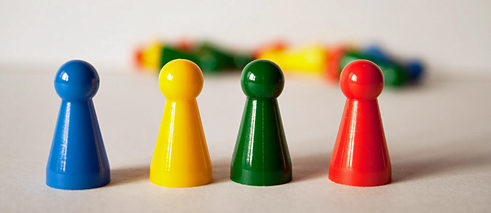Parlour games
A playful pastime

The days of parlour games are far from numbered even in the age of the computer game. On the contrary, German games are also popular across the national borders.
Little by little the play group trundles in. They greet each other, briefly exchange gossip, Luna, the dog, makes herself comfortable under the table. And soon the four women, between the ages of fifty and eighty, are deep into their game of cards. “We met twenty-five years ago through a newspaper ad and have been meeting ever since every fourteen days to play Doppelkopf”, says Barbara Böhlke. The game night has had a permanent place in her calendar for a quarter of a century.
The North German group’s joy in playing is by no means exceptional: almost every second German (47 per cent) passes at least occasionally some of his or her time with board, card or other parlour games, according to a 2015 survey of the market research institute Ipsos.
Charm and mystery of play
The drive to play is deeply rooted in people. Playing is fun, arouses motivation and sets learning processes in motion. The German playwright and poet Friedrich Schiller already recognized the importance of play: “Man plays only when he is in the full sense of the word a man, and he is only wholly Man when he is playing”.To this day, however, there is still no generally accepted definition of what is to be understood by “play”. The question about why playing is fun has also not been conclusively answered. That play has been so difficult to grasp may have to do with the contradictions it harbours: after all, on the one hand it allows us to escape the everyday round; on the other hand, the player can play only when he or she complies with a set of rules. That play is fun does not exclude that it is also carried on with great seriousness. And finally, play makes room for much that is not possible in reality: to slip into strange roles, to take risks without consequences, and to gain comparatively easy victories and recognition.
A good game, according to Harun Maye, a scientist at the International Research Institute for Cultural Technologies and Media Philosophy (IKKM) at the Bauhaus University in Weimar, must above all be “replayable. A game that people don’t want to play several times isn’t really fit to be played once or twice”.
Games as an economic factor
Germany is a country of games, and not only because games meetings such as Barbara Böhlke’s Doppelkopf group are part and parcel of German leisure activities. It is in Germany that the “Game of the Year” prize is awarded, the most important award in the industry. The largest international public fair for parlour games, SPIEL, takes place annually in Essen, and Upper Franconia is the publication site of spielbox, the board games magazine with the largest circulation in the world. “The sale of over 30 million games generates an annual turnover of 400 million euros”, says Hermann Hutter, Chairman of the Association of Games Publishers, summing up the market situation. With 20 to 50 per cent of this consisting in German games sold abroad, games also constitute a major export.Typically German
This international triumph was initiated by the cult game “The Settlers of Catan” (Die Siedler von Catan), which was developed in Germany. Celebrating its twentieth anniversary in 2015, it has sold more than 22 million copies and been translated into 30 languages. Ever since “Catan’s” success, German board games such as it or “Carcassonne” have gained an excellent reputation throughout the world. Even more: the so-called “German-style” game, an author’s game with comparatively simple rules, an overarching theme and a manageable duration, is now the description of an entire genre. “German-style” refers not to national origin but rather is a synonym for challenging, high quality games.Digital competition
By its own accounts, the analogue gaming industry has nothing to fear from the digital competition. After all, in 2015 the demand for parlour games in Germany increased by 11 per cent compared with the same period of the previous year. Hermann Hutter sees a “peaceful co-existence” between analogue and digital games. Moreover, so-called “hybrid games”, the combination of traditional board games with electronic components, form a new genre: new gaming experiences arise when the smartphone explains the rules, monitors the moves and counts the points, or the tablet serves as the play board. Board games are also increasingly being transferred to apps and can then be played on smartphones.Other playing principles are also protection against the digital competition: in so-called “pen-&-paper’ role-playing games, participants assume a fictional role and together experience a joint adventure through telling about it. The pen and paper serve as the main game materials for noting the roles, and often dice or other random elements are also used. Mixtures of board and improvisation stories such as The Dark Eye (Das Schwarze Auge) constitute, according to Harun Maye, the avant-garde of analogue parlour games: the jointly experienced adventure made possible by relating stories to each other “cannot be simulated by a computer game, but can be experienced only by sitting together at a table”. Socializing is probably always part of the fun of playing. Barbara Böhlke can only second this: “I grew up with card games and just like to play, but part of our card evenings is that we all understand each other so well”.
Discuss with us
Are board games in keeping with the times? What do people play in your country? Tell us your opinion.